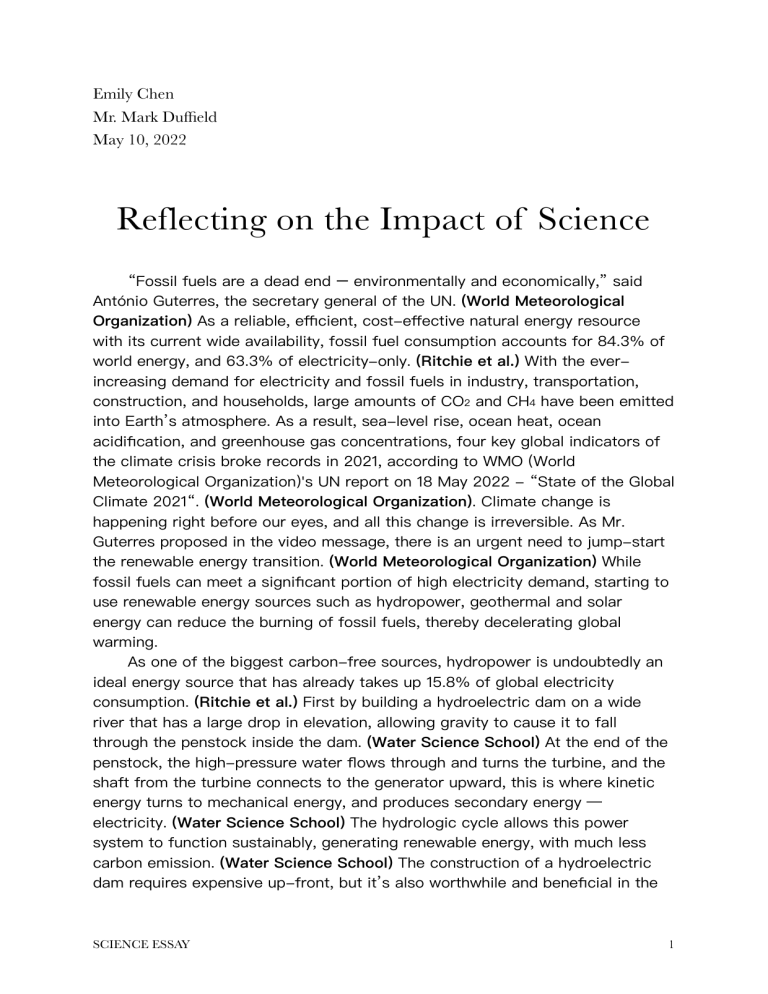
Emily Chen Mr. Mark Duf eld May 10, 2022 Reflecting on the Impact of Science “Fossil fuels are a dead end – environmentally and economically,” said António Guterres, the secretary general of the UN. (World Meteorological Organization) As a reliable, e cient, cost-e ective natural energy resource with its current wide availability, fossil fuel consumption accounts for 84.3% of world energy, and 63.3% of electricity-only. (Ritchie et al.) With the everincreasing demand for electricity and fossil fuels in industry, transportation, construction, and households, large amounts of CO2 and CH4 have been emitted into Earth’s atmosphere. As a result, sea-level rise, ocean heat, ocean acidi cation, and greenhouse gas concentrations, four key global indicators of the climate crisis broke records in 2021, according to WMO (World Meteorological Organization)'s UN report on 18 May 2022 - “State of the Global Climate 2021“. (World Meteorological Organization). Climate change is happening right before our eyes, and all this change is irreversible. As Mr. Guterres proposed in the video message, there is an urgent need to jump-start the renewable energy transition. (World Meteorological Organization) While fossil fuels can meet a signi cant portion of high electricity demand, starting to use renewable energy sources such as hydropower, geothermal and solar energy can reduce the burning of fossil fuels, thereby decelerating global warming. As one of the biggest carbon-free sources, hydropower is undoubtedly an ideal energy source that has already takes up 15.8% of global electricity consumption. (Ritchie et al.) First by building a hydroelectric dam on a wide river that has a large drop in elevation, allowing gravity to cause it to fall through the penstock inside the dam. (Water Science School) At the end of the penstock, the high-pressure water ows through and turns the turbine, and the shaft from the turbine connects to the generator upward, this is where kinetic energy turns to mechanical energy, and produces secondary energy — electricity. (Water Science School) The hydrologic cycle allows this power system to function sustainably, generating renewable energy, with much less carbon emission. (Water Science School) The construction of a hydroelectric dam requires expensive up-front, but it’s also worthwhile and bene cial in the fi ff fl ffi 1 fi fi fi SCIENCE ESSAY fl 2 ff fl fl fl ff ffi fi fl SCIENCE ESSAY ff fl long run since the facility can function for at least 50 years with constant electricity production. Water stored in the dam can also be used for irrigation. (“Pros and Cons of Hydropower | EnergySage”) Furthermore, it’s produced domestically, which means the country can take full control over its distribution, so there’s less worry to be a ected by political standpoint and resulting in energy being cut o , monopolized by other countries. The only disadvantage is that it relies on the local hydrology, but as long as the facility is constructed in a location with su cient and constant rainfall, the impact of occasional droughts is negligible. As it can be seen from Figure 1, in the year 2021, hydropower accounted for roughly 15.34% of China’s electricity production while fossil fuel takes up 66.95%. (Ritchie et al.) This shows that there is still much space for improvement in the energy transition. But overall, being in the third place in China’s electricity production ranking with Figure 1. Share of electricity 4206 terawatt-hours of hydroelectric power production from hydropower (China) shows its massive potential and a good start. Geothermal energy is a carbon-free, sustainable energy source that is still largely unexploited. As shown in Figure 2, it’s currently accounted for less than 2.5% of the global electricity consumption. (Ritchie et al.) There are three types of electricity plants with di erent systems to harness geothermal energy. The rst one is called ‘dry steam’, it’s similar to burning fossil fuels, by having steam above 150°C owing from the reservoir to provide the mechanical force required to spin the turbines, and then generate electricity with the generator connected. (ERCE) The second method is Figure 2. Shares of different energy called ‘ ash steam’, water with temperatures source from total energy/electricityabove 180°C pumps up through wells in the only consumption (worldwide) ground by its pressure. (ERCE) It is kept under pressure until it is ‘ ashed’ at the surface to produce steam. (ERCE) The remaining water and condensed steam will be injected back into the reservoir, to gain heat from the surroundings and be reused. (ERCE) The third method is the binary cycle power plant. Water with temperatures as low as 100°C is pumped up through wells. The heat from the hot water boils a second uid that has a low boiling point, aka the ‘working uid’. (ERCE) The vaporized working uid pushes the turbines, then condenses, fl and is vaporized again by the continued supply of heat from the geothermal waters. (ERCE) The geothermal water is sent back into the ground to be reheated for the next cycle. (ERCE) The most obvious advantages of geothermal energy are environmentally friendly and renewable, the whole process of generating electricity goes underground with no greenhouse gas or waste created during the process. Another advantage of geothermal energy is that they are available everywhere on earth as long as you have the technologies to build the power plant enough deep and the permission from the local government. However, geothermal energy runs the risk of triggering earthquakes, due to its exploitation of the Earth. (TWI) This problem is more common with enhanced geothermal power plants, which force water into the Earth’s crust with wider gaps. (TWI) But considering that most geothermal plants are away from the population centers, the impacts of earthquakes caused by the exploitation are relatively minor. Another disadvantage of geothermal energy is that they are not mature enough, at the moment, new technologies are in the exploration stage to improve the energy process. For example, to maintain the sustainability of the geothermal energy, the ‘working uid’ needs to be pumped into the underground reservoirs faster than it depletes, technologies are being created to solve this problem. (TWI) As demonstrated in Figure 3, the global evolution of geothermal power started in 1950 and reached 14600MW of installed capacity by 2018. (Zhang et al.) Thus, we can conclude that there is a market, demand, and basic practice of geothermal energy, and so, this technology will likely Figure 3. Geothermal power installed to develop further. Overall, geothermal capacity evolution in the world from energy is an ideal renewable energy 1950 to 2018 source with great potential to replace fossil fuels even though it’s still in development. As a renewable energy that can be harnessed directly from the sun, solar power has been widely recognized, as shown in Figure 4, its worldwide Installed Capacity has grown steadily during the past ten years, from 2011 to 2021. (IRENA) Furthermore, the growth of solar power’s Installed Capacity in China has accelerated during the three years between 2015 and 2018 as displayed in Figure 5. (IRENA) There are two ways of SCIENCE ESSAY Figure 4. Solar power installed capacity evolution in the world from 2011 to 3 2021 References ERCE. “Untapped Geothermal Energy - ERCE.” ERCE, 21 Dec. 2020, www.erce.energy/latestnews/untapped-geothermal-energy/. Accessed 19 May 2022. IRENA (International Renewable Energy Agency). “Solarn Energy.” Irena.org, 2022, www.irena.org/solar. Accessed 20 May 2022. “Pros and Cons of Hydropower | EnergySage.” Energysage.com, 2021, www.energysage.com/about-clean-energy/hydropower/pros-conshydropower/. Accessed 20 May 2022. Ritchie, Hannah, et al. “Energy.” Our World in Data, 28 Nov. 2020, ourworldindata.org/electricity-mix. Accessed 19 May 2022. ff 4 ffi ff fi ff SCIENCE ESSAY ff generating solar power, photovoltaics (PV) and Concentrated solar power (CSP). (IRENA) Compared with PV, which can be used for both personal use and commercial scale, CSP can only be used industrially, because CSP requires largescale power plants to generate electricity with cost-e ectiveness and e ciency. CSP has the same mechanism to generate electricity as burning fossil fuels, both by heating the water rst, then operating the Figure 5. Solar power installed capacity turbine with steam and so to generate evolution in China from 2011 to 2021 electricity, the only di erence is that the source of heat used to evaporate water is di erent - in this case, solar rays are concentrated by mirrors to heat the water instead of burning fossil fuels. With advantages such as diverse application, low maintenance, and long-term cost-e ectiveness, solar power have limitations of weather dependent and relatively high space occupation. Hydropower, geothermal energy and solar energy are good alternatives to fossil fuels as low-carbon, renewable energy sources. Existing examples and data have proven they are feasible and able to meet the high electricity demand of households, while reduce environmental consequences of large energy consumption of fossil fuels - global warming. However, they still have a lot of work to do in completing the technology’s development, which can be done with time. Overall, their potential outweighs the limitations, and most importantly, they represent an important advance in addressing global warming. TWI. “What Are the Advantages and Disadvantages of Geothermal Energy?” Twi-Global.com, 2022, www.twi-global.com/technical-knowledge/ faqs/geothermal-energy/pros-andcons#WhataretheAdvantagesofUsingGeothermal. Accessed 20 May 2022. Water Science School. “Hydroelectric Power: How It Works | U.S. Geological Survey.” Usgs.gov, 30 Aug. 2018, www.usgs.gov/special-topics/waterscience-school/science/hydroelectric-power-how-it-works. Accessed 20 May 2022. World Meteorological Organization. “Four Key Climate Change Indicators Break Records in 2021.” World Meteorological Organization, 18 May 2022, public.wmo.int/en/media/press-release/four-key-climate-change-indicatorsbreak-records-2021. Accessed 20 May 2022. Zhang, Lei, et al. “Geothermal Power Generation in China: Status and Prospects.” Energy Science & Engineering, vol. 7, no. 5, 29 May 2019, pp. 1428–1450, onlinelibrary.wiley.com/doi/epdf/10.1002/ese3.365, 10.1002/ ese3.365. Accessed 20 May 2022. SCIENCE ESSAY 5


